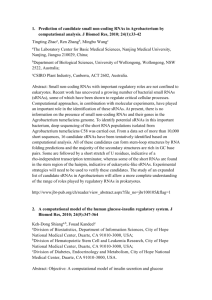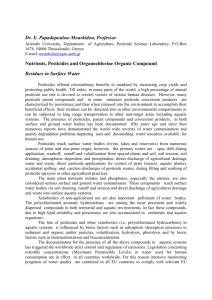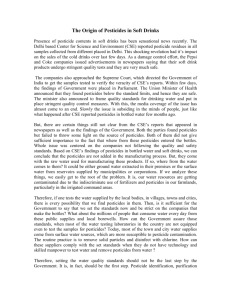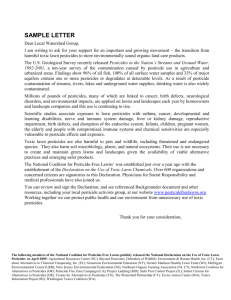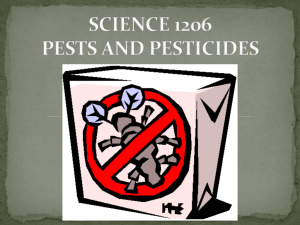Fate, Transport, and Biodegradation Products of Organophosphorus
advertisement
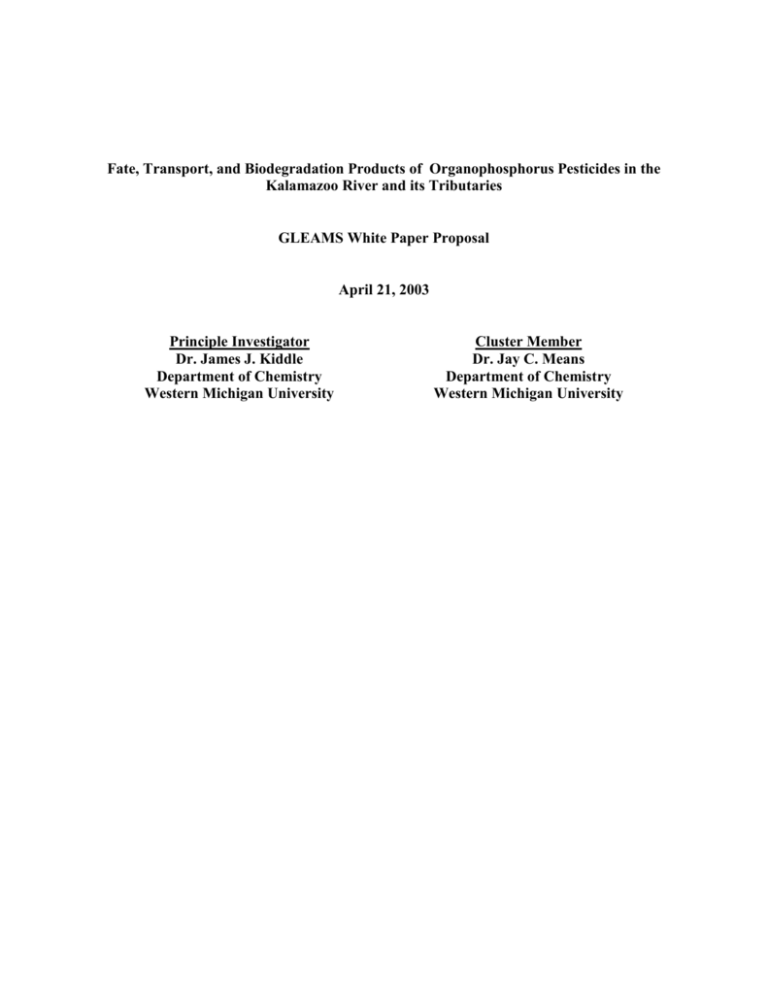
Fate, Transport, and Biodegradation Products of Organophosphorus Pesticides in the Kalamazoo River and its Tributaries GLEAMS White Paper Proposal April 21, 2003 Principle Investigator Dr. James J. Kiddle Department of Chemistry Western Michigan University Cluster Member Dr. Jay C. Means Department of Chemistry Western Michigan University Organophosphorus pesticides (OPP) and herbicides are a diverse class of agents for the control of a variety of pests. While organophosphorus pesticides are significantly more labile than organochlorine pesticides, their residues are distinctly detectable in environmental matrices.1 Surveys of surface waters in agricultural watersheds have detected the presence of organophosphorus pesticides in a variety of aquatic systems.2 Although the organophosphorus pesticides are more labile, biodegradation and metabolism produce compounds that are acutely toxic to both invertebrate and vertebrate animals.3 In addition, mishandling and indiscriminate application of organophosphorus pesticides is clearly increasing their prevalence in the aquatic environment.4 Despite the hazards of organophosphorus pesticides to the aquatic environment, very little is known about the chemistry of their fate and transport, as well as their biotransformations in many aquatic systems. In fact, the stability of organophosphorus pesticides in water is still controversial, with significantly different opinions from various governmental commissions and surveys.5 In addition, many of the studies of the persistence of organophosphorus pesticides in water to date were carried out under conditions not normally found in the environment, specifically, in sterile water, under dark conditions, and at a high concentration of the pesticide. Furthermore, the transformations of organophosphorus pesticides, in aquatic systems, to compounds that show the acute toxic effects have not been explored. The pathways in Scheme 1 depict common degradations/transformation routes for many organophosphorus pesticide compounds in aquatic environments. The extent to which these transformations occur depends greatly on the structure of the OPP and the prevailing environmental conditions. The reaction pathways in Scheme 1 are known to occur under a variety of hydrolytic, oxidative, and thermal conditions. These conditions have also been described as reaction pathways occurring in the surface layer of fresh-water aquatic environments. At present, the fate of the parent OPP compounds, and the products of degradation/transformation in these aquatic environments is unknown. It is the specific aim of this research to determine the distribution of the parent organophosphorus pesticides, as well as their degradation/transformation products in the Kalamazoo River and its tributaries. Scheme 1 O OCH2CH3 R O P OCH2CH3 31 P NMR = 0 to -10 ppm oxon-species Hydrolysis -O 31 O OCH2CH3 P OCH2CH3 P NMR = -4.32 Oxidation S OCH2CH3 R O P OCH2CH3 P NMR = 60 to 80 ppm parent OPP compound 31 Hydrolysis -S 31 O OCH2CH3 P OCH2CH3 P NMR = -44.0 Isomerization O SCH2CH3 R O P OCH2CH3 31 P NMR = 20 to 35 ppm iso-species Hydrolysis -O O SCH2CH3 P OCH2CH3 31 P NMR = -12.68 The long term goals of this project will be to determine the environmental impact of organophosphorus pesticides on the Great Lakes and its associated watersheds. To begin these investigations we propose to determine the identity and, where possible, the chemical and biological degradation products of organophosphorus pesticides utilized in the Southwest region of Michigan along the Kalamazoo River. To accomplish these goals we plan to test water samples from the Kalamazoo River, and its tributaries, especially those with runoff from agricultural sources and golf courses for the presence of OPP compounds. The investigations will use two analytical techniques, phosphorus-31 (31P) NMR spectroscopy and LC-MS (liquid chromatography/mass spectrometry), to identify and then verify the identity of all OPP compounds present in the water samples. The use of 31P NMR is ideal for these compounds since their chemical shifts () show a broad range of values. In fact, an investigation of the literature of 31P NMR chemical shifts for organophosphorus pesticides (>50 pesticides) suggests that we can in fact distinguish between individual organophosphorus pesticides and degradation products based solely on their 31P NMR chemical shifts.6 Moreover, since 31P is in 100% abundance in nature, concentration data and kinetic information about rate constants for determination of environmentally relevant chemical reaction can be directly obtained from integration of the 31P NMR signals.7 In addition, the 31P NMR samples do not require any preparation, like some other analytical techniques, making this a potentially rapid method for the determination of organophosphorus pesticides in natural water samples. However, because of a lower sensitivity then other analytical techniques NMR spectroscopy has not been fully recognized as a general tool for the determination of these types of data for environmental studies. Therefore, it is also proposed to examine the samples by LCMS, a well established technique for these types of studies, to verify and validate our 31P NMR data and methodology. The availability of these data should make an important contribution to the Geographic Information System (GIS) mapping of contaminants and their movement in the Great Lakes and associated watersheds. In addition, even with only limited concentration data it should be possible to obtain information about the rate constants for the chemical transformations of the OPP compounds outlined in Scheme 1,8 and incorporate these data about hydrolysis products into the GIS electronic mapping. These data will be especially important since the products of hydrolysis represented in Scheme 1 are phosphate type molecules and have been shown to promote eutrophication of water bodies thus, having a long-term effect on the trophic status of the receiving water bodies and indirectly the organisms present. This indirect connection to the organisms present in the water bodies would then have a potential impact on human health in the same region. In summary, we propose the initiation of a comprehensive examination of the presence of organophosphorus pesticides in the Great Lakes and its associated watersheds. The initial investigations planned would focus on the establishment of a new method for the detection of organophosphorus pesticides in the Kalamazoo River, and its tributaries to provide details about the fate and transport, as well as potential biodegradation pathways for these compounds. These data would then provide GIS mapping of these potential contaminants in the Kalamazoo River and its tributaries. Additionally, these efforts would provide the foundation for a variety of future collaborative research ventures that could include studies of sediments and soil samples for organophosphorus pesticides to further expand the scope of our understanding of the fate and transport of these compounds in the Great Lakes regions. References 1. Racke, K.D. Degradation of Organophosphorus Insecticides in Environmental Matrices. In Organophosphates Chemistry, Fate, and Effects; Chambers, J.E.; Levi, P.E., Eds.; Academic Press: New York, 1992. pp 47-78. 2. Baker, D.B.; Richards, R.P. The Transport of Soluble Pesticides Through Drainage Networks in Large Agricultural River Basins. Water Qual. Lab. Report, Heidelberg College, Tiffin, Ohio. 3. Minton, N.A.; Murray, V.S.G. A Review of Organophosphate Poisoning. Medical Toxicology 1988, 3, 350-375. 4. Durairaj, S.; Selvarajan, V.R. Synergistic Action of Organophosphorus Pesticides on Fish, Oreochromis mossambicus. J. Environ. Biol. 1995, 16, 51-53. 5. Munch, D.J.; Frebis, Ch.P. Analyte Stability Studies Conducted During the National Pesticide Survey. Environ. Sci. Technol. 1992, 26, 921-925. 6. Kiddle, J.J. unpublished results. 7. Quin, L.D.; Verkade, J.G. Phosphorus-31 NMR Spectral Properties in Compound Characterization and Structural Analysis; VCH Publishers: New York, 1994. 8. Von Arx, K.B.; Manock, J.J.; Huffman, S.W.; Messina, M. Using Limited Concentration Data for the Determination of Rate Constants with the Genetic Algorithm. Environ. Sci. Technol. 1998, 32, 3207-3212.


